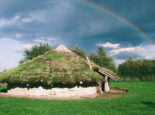A history of Peterborough in six chapters…
[prev] …‘did most miserably deface the Cathedral Church, breake downe the Organs, and destroy the glasse windowes, committing many other outrages on the house of God which were not acted by the Gothes in the sack of Rome’. If that report seems to be lacking journalistic balance, we should not be too surprised. It’s taken from Mercurius Aulicus – a Royalist newspaper. Cromwell didn’t get away scot-free, however. For several days he was confined to bed with concussion, having ridden under an arch that was slightly lower than he’d anticipated. It is not recorded whether anyone dared to laugh.
Prisoners of the Napoleonic Campaigns
For ordinary people living away from the coast, the threat from Napoleon must have seemed distant. But one thing brought it very close to home.
In 1796, the first purpose-built prisoner-of-war camp in the world was built at Norman Cross. It was intended to be a model prison. The 5,500 inmates – most of whom were ordinary fighting men or sailors – were well fed, each recieving a ration of 1lb of beef, bread, potatoes fresh vegetables and beer every day – with fish on Fridays to accomodate Roman Catholics. Officers were afforded special privileges and were permitted to walk free outside of the prison, which many did. Some even dined out, and are recorded to have done so in full French Naval uniform – which must have given Peterborough residents something of a shock.
A few opted to remain – some having married whilst here
Clothing proved a vexing issue for other inmates, however. The British government complained to the French Consul that the French prisoners were routinely selling their own clothes to fund gambling habits. Surprising as it may sound, prisoners were permitted to earn money, and many did so by selling artefacts they had made at the local market. Some prisoners are reported to have earned as much as 100 guineas – a fortune by modern standards. A few took their creativity a little too far, however – such as the pair who were caught forging £1 notes.
In 1814 when peace was at last achieved, prisoners, guards and local people celebrated together, and the prisoners were finally allowed home. A few opted to remain – some having married whilst here.
Two World Wars
Over a thousand men from the city were killed during the First World War. Astonishingly, however, there was no standing memorial recording their names until Sunday, 11th November, 2007. On that day, a new memorial was installed next to the Second World War memorial in the Sprite Chapel in Peterborough Cathedral – the place that has remained a constant throughout so much of the city’s history.
An early military airfield was also established nearby in 1916, known as RFC Stamford. By 1924, the Royal Flying Corps had changed its name to the Royal Air Force, and the airfield had become RAF Wittering. During the Second World War, this was the main fighter station for much of the southern part of the East Midlands, seeing a good deal of action during the Blitz – during which Peterborough Cathedral was twice saved from incendiary bombs by ARP Wardens. The station itself was bombed at least five times, with seventeen people being killed on 14 March 1941 – but its pilots were credited with bringing down 151 enemy aircraft and 89 V-1 flying bombs.
Meanwhile, at nearby Polebrook, one of the new American servicemen was causing a bit of a stir. It was Clark Gable, stationed there as captain of a B-17 bomber crew. He was not universally popular, however – Adolph Hitler instructed Hermann Goering to offer a reward to any pilot who shot Gable down.
What next?
And so another chapter begins. Our chapter. How we are judged will be for future generations to decide – but maybe we should go a bit easier on the Cathedral this time…















